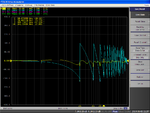ronzino
Newbie level 4
Hello,
I have a problem with inductance and capacitance measure of a transmission line 4 Kilometers long.
The attenuation and characteristic impedance are good, but L and C suddenly fall down and start oscillate.
In order to calculate RLGC model I have exported s-parameters touchstone file from my agilent e5061B, and processed with matlab.
The transmission line is HUGE as it will be used for energy distribution is wrapped around a metallic reel long about 15meters and with an height of 2.
what could determine the strange effect on L e C ?


I have a problem with inductance and capacitance measure of a transmission line 4 Kilometers long.
The attenuation and characteristic impedance are good, but L and C suddenly fall down and start oscillate.
In order to calculate RLGC model I have exported s-parameters touchstone file from my agilent e5061B, and processed with matlab.
The transmission line is HUGE as it will be used for energy distribution is wrapped around a metallic reel long about 15meters and with an height of 2.
what could determine the strange effect on L e C ?




